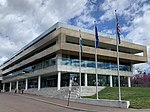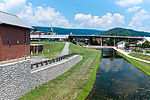House of Sweden
2006 establishments in Washington, D.C.Buildings and structures completed in 2006Commons category link is locally definedDiplomatic missions in Washington, D.C.Diplomatic missions of Iceland ... and 7 more
Diplomatic missions of SwedenGeorgetown (Washington, D.C.)Gert Wingårdh buildingsIceland–United States relationsInterlanguage link template existing linkLiechtenstein–United States relationsSweden–United States relations

House of Sweden is a building in Washington, D.C., in which is located the Embassy of Sweden and the diplomatic missions of the Republic of Iceland and the Principality of Liechtenstein to the United States. The building is located at 2900 K Street N.W. in the Georgetown neighborhood.Apart from the embassies, the building, which is owned by the Swedish state through its National Property Board, also houses representatives of Swedish commerce. Facilities includes a secretariat, exhibition space, 19 corporate office suites, and a high-tech business event center.
Excerpt from the Wikipedia article House of Sweden (License: CC BY-SA 3.0, Authors, Images).House of Sweden
30th Street Northwest, Washington Georgetown
Geographical coordinates (GPS) Address External links Nearby Places Show on map
Geographical coordinates (GPS)
| Latitude | Longitude |
|---|---|
| N 38.901469444444 ° | E -77.058855555556 ° |
Address
House of Sweden
30th Street Northwest 901
20007 Washington, Georgetown
District of Columbia, United States
Open on Google Maps








